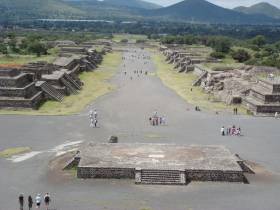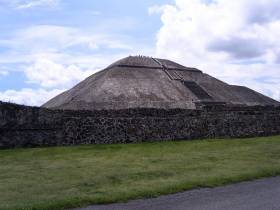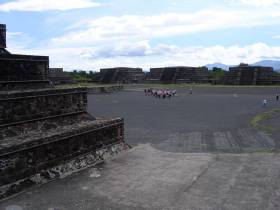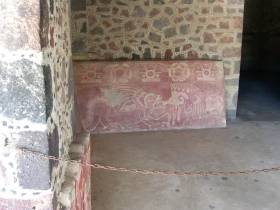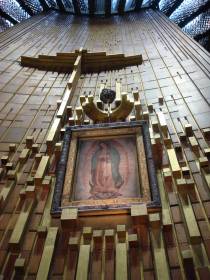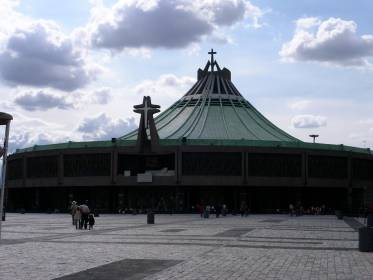Teotihuacan (Monday 27/08/07)
For reasons of traffic you should visit Teotihuacan in the morning. For convenience, we endorsed one of the many taxi drivers affiliated with the hotel, and it was good.
As a first step took us to the place of a cooperative living by making Obsidian objects and multicolored fabrics made of cotton and agave. They shown us the working of obsidian, how to build cord from the agave and how to extract the Pulche, agave lymph, which can be drunk as it is slightly alcoholic (not bad after all).
Subsequently, the driver took us to the Pyramid of the Moon and he waited us at the end of the Way of the Dead, but only after making a long introduction to the site and having us hear the cry of an ancient extinct bird, a strange acoustic effect produced clapping in the middle of the squares of some archaeological sites (also at Chichen Itza).
Teotihuacan where "men become gods"
Lying forty kilometers northeast of Mexico City, the city is located in a huge valley in the middle of the arid mountains, it was the largest city and capital of Mexico's largest pre-Columbian empire.
It is one of the most important archaeological sites. In its period of maximum splendor, the place where “men became gods”, was inhabited by 250,000 people. It was founded in 150 BC in a strategic position, by the excellent climate, capable of controlling the traffic to the Gulf of Mexico. From farming town soon became a manufacturer of obsidian and trade center.
Today is one of the most visited sites of Mexico and the local population continues to live on the production of obsidian, manufacturing beautiful pieces based upon models collected in different sites of the country.
In the seventh century began its decline. I Its inhabitants abandoned it in 750.
Entering you see the Great Sacred Way, Avenida de los Muertos, the main axis, is flanked by wide platform for the celebration of religious rites.
The Great Sacred Way leads to Ciudadela, built in the classical period, reaches a considerable length of 400m. It consists of four platforms and preserves the Temple of Quetzalcoatl, whose facade has fine examples of Teotihuacan tablero. The steps of the temple is flanked by numerous alfarda with huge heads of plumed serpent.
On the left rises the gigantic the Pyramid of the Sun: a square base with 225m and 63m high, 365 steps.
Get ready for a long, steep climb (in the whole site there are also steps on the road in plain …), but from the top the view is remarkable.
At the north stands, in the Plaza de la Luna, the Pyramid of the Moon: 46m high, formed by four superimposed levels, with 112 steps.
This ascent was certainly easier to accomplish than the climb to the Pyramid of the Sun, also because it was limited the first steps, as you can not climb to the top.
The Plaza de la Luna includes other buildings such as the Palace of the Butterfly or Placio del Quetzalpapalotl, with a patio that has several columns with depictions of the Quetzal Butterfly, the Patio of the Jaguars with traces of paintings and the Temple of the fledged shells dating back to second century.
Guadalupe, Our Lady India
In December 9, 1533 the Virgin appeared close in a cloak embroidered with gold, to the Indian Juan Diego in the woods, on the Cerro El Tepeyac, where once stood the Aztec temple of the goddess Tonantzin, mother of the gods. Our Lady asked him to build a chapel in her honor, but the bishop, Fray Juan de Zumarraga, gave no regard to the words of Juan Diego. The Mother of Christ, then clear again, imprinting his image on the white mantle of indium and telling him to gather the roses that grew in that place and to bring them along to the mantle, to the prelate.
The coat is hung above the marble altar of the new Basilica.
Since then, Our Lady of Guadalupe was the saint patron of Mexico. Thus the work of conversion of indigenous peoples was also facilitated by this prodigy, used instrumentally by Spanish clergy.



